CNN says that, with Biden’s proposal to give Amtrak $80 billion, “Amtrak’s moment may finally have arrived.” But what would it mean for Amtrak to have a “moment”? Would it mean that passenger trains return to once again become an important source of transportation, as they were in the 1920s? Or does it mean that Amtrak will get a lot more money for continuing to carry a trivial share of the nation’s passenger travel?
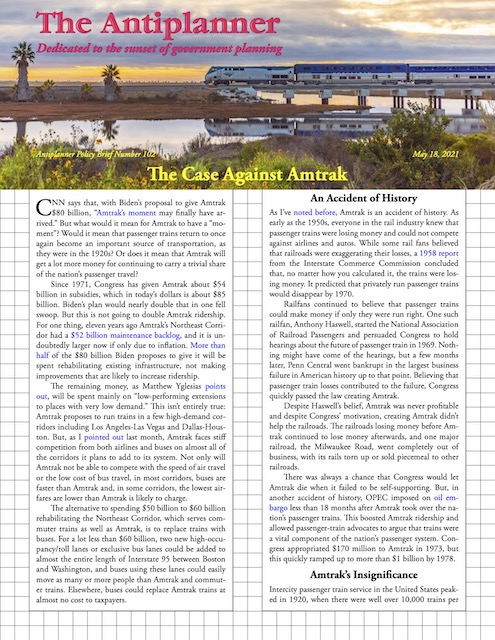 Click image to download a five-page PDF of this policy brief.
Click image to download a five-page PDF of this policy brief.
Since 1971, Congress has given Amtrak about $54 billion in subsidies, which in today’s dollars is about $85 billion. Biden’s plan would nearly double that in one fell swoop. But this is not going to double Amtrak ridership. For one thing, eleven years ago Amtrak’s Northeast Corridor had a $52 billion maintenance backlog, and it is undoubtedly larger now if only due to inflation. More than half of the $80 billion Biden proposes to give it will be spent rehabilitating existing infrastructure, not making improvements that are likely to increase ridership.
The remaining money, as Matthew Yglesias points out, will be spent mainly on “low-performing extensions to places with very low demand.” This isn’t entirely true: Amtrak proposes to run trains in a few high-demand corridors including Los Angeles-Las Vegas and Dallas-Houston. But, as I pointed out last month, Amtrak faces stiff competition from both airlines and buses on almost all of the corridors it plans to add to its system. Not only will Amtrak not be able to compete with the speed of air travel or the low cost of bus travel, in most corridors, buses are faster than Amtrak and, in some corridors, the lowest airfares are lower than Amtrak is likely to charge.
The alternative to spending $50 billion to $60 billion rehabilitating the Northeast Corridor, which serves commuter trains as well as Amtrak, is to replace trains with buses. For a lot less than $60 billion, two new high-occupancy/toll lanes or exclusive bus lanes could be added to almost the entire length of Interstate 95 between Boston and Washington, and buses using these lanes could easily move as many or more people than Amtrak and commuter trains. Elsewhere, buses could replace Amtrak trains at almost no cost to taxpayers.
An Accident of History
As I’ve noted before, Amtrak is an accident of history. As early as the 1950s, everyone in the rail industry knew that passenger trains were losing money and could not compete against airlines and autos. While some rail fans believed that railroads were exaggerating their losses, a 1958 report from the Interstate Commerce Commission concluded that, no matter how you calculated it, the trains were losing money. It predicted that privately run passenger trains would disappear by 1970.
Railfans continued to believe that passenger trains could make money if only they were run right. One such railfan, Anthony Haswell, started the National Association of Railroad Passengers and persuaded Congress to hold hearings about the future of passenger train in 1969. Nothing might have come of the hearings, but a few months later, Penn Central went bankrupt in the largest business failure in American history up to that point. Believing that passenger train losses contributed to the failure, Congress quickly passed the law creating Amtrak.
Despite Haswell’s belief, Amtrak was never profitable and despite Congress’ motivation, creating Amtrak didn’t help the railroads. The railroads losing money before Amtrak continued to lose money afterwards, and one major railroad, the Milwaukee Road, went completely out of business, with its rails torn up or sold piecemeal to other railroads.
There was always a chance that Congress would let Amtrak die when it failed to be self-supporting. But, in another accident of history, OPEC imposed on oil embargo less than 18 months after Amtrak took over the nation’s passenger trains. This boosted Amtrak ridership and allowed passenger-train advocates to argue that trains were a vital component of the nation’s passenger system. Congress appropriated $170 million to Amtrak in 1973, but this quickly ramped up to more than $1 billion by 1978.
Amtrak’s Insignificance
Intercity passenger train service in the United States peaked in 1920, when there were well over 10,000 trains per day and per capita rail travel peaked at more than 750 miles per year. Early data are a bit uncertain, but in 1920, intercity passenger trains carried Americans more than 40 billion passenger-miles. Transit, including commuter trains, carried people about 80 billion passenger-miles. Americans drove about 48 billion vehicle-miles, and vehicle occupancies were probably greater than today because family sizes were larger. If the average auto carried 2.0 people instead of today’s 1.7, then intercity trains carried about 18 to 19 percent of all passenger travel in the United States.
Rail’s share of passenger travel was already low before Amtrak took over, and it has significantly diminished since then despite large subsidies.
Department of Transportation data indicate that, by 1960, rail passenger miles had fallen to 17 billion while driving and flying had grown so that intercity trains carried less than 1.5 percent of passenger travel. In 1970, the last year of private passenger service before Amtrak took over, rail passenger miles were down to 6.2 billion, which was less than 0.3 percent of passenger travel. Amtrak immediately killed more than half of the nation’s passenger trains, so in 1975, even after the OPEC oil embargo, it carried just 0.16 percent of travel. Amtrak ridership has grown since then, but not as fast as highway or air travel, so in 2019 Amtrak’s share was less than 0.11 percent.
Debating the Case for Amtrak
Despite Amtrak’s insignificant market share and its failure to increase that market share, passenger-train supporters still want taxpayers to subsidize Amtrak. Here are the reasons they give for such support and why those reasons are not valid.
1. All transportation is subsidized: Actually, not all transportation is subsidized. The nation’s seven class 1 freight railroads operate largely without subsidies; the only subsidies are mainly subsidies to a few shippers. Except in times of crisis such as 9/11 or the pandemic, the nation’s airlines have been largely unsubsidized; the main subsidies have been to little-used airports in small communities that Congress has (for political reasons) deemed need “essential air service.”
Relative to Amtrak subsidies, the subsidies that exist for air and highway travel are small. In 2019, air travelers received subsidies averaging 1.1 cents per passenger mile (mainly, as noted, to smaller airports) and highway subsidies averaged about the same. Amtrak subsidies, however, were 36 cents per passenger mile. Since Amtrak fares averaged 38 cents per passenger mile, almost half the cost of riding Amtrak was subsidized compared with 7 percent of the cost of flying and 4 percent of the cost of driving.
2. Other countries subsidize trains: China has spent hundreds of billions of dollars building new passenger train lines. China also politically represses its people in many different ways, but no one would suggest that the United States should engage in such repression just because China does.
Taxing people to pay for train rides they rarely if ever take is a form of economic oppression, and it is particularly bad considering that most taxes are regressive and most passenger train riders are economically well off. Just because other countries engage in such economic oppression doesn’t mean that the United States should as well.
Profits aren’t just a way for capitalists to get rich. They are a sign that you are doing something right. If people are willing to pay all of the costs of what you are doing, then you are producing net economic value. If they aren’t, and you demand that they pay anyway in the form of taxes, then you are producing net economic losses.
3. Passenger trains work well in Europe: European passenger trains work great for American tourists who are willing to confine their travel to places reached by such trains. They don’t necessarily work well for European residents. According to Eurostat, passenger trains carried 7.8 percent of travel in the European Union in 2019. While that is considerably higher than Amtrak’s 0.1 percent, it is still not very much. Moreover, it overstates the number for two reasons.
First, the EU number includes urban rail travel such as trams, metros, and commuter trains. About 18 percent of that 7.8 percent is urban rail, leaving 6.4 percent for intercity trains. Second, in calculating market share, the EU leaves out air travel. In 2006, air travel within Europe accounted for 42 percent more passenger-kilometers than intercity rail travel. From 2006 to 2019, air travel (measured in passengers) grew by more than 50 percent, while rail travel (measured in passenger-kilometers) grew by less than 22 percent. Assuming the average airline trip was about the same number of kilometers in 2019 as in 2006, intercity rail’s share of travel including air travel was just 5.7 percent in 2019, down from 6.1 percent in 2006. Rail subsidies haven’t kept European passenger trains from losing market share.
Nor are claims that passenger trains in some European countries make money valid. A report by Amtrak’s inspector general looked at such claims and discovered that many major costs, including capital costs, debt service, and pensions, are paid for by national governments and not shown on the books of the state-owned railroads found in most European countries. For example, the Economist once reported that the French national railroad “earned a profit of 695 million euros in 2006.” Amtrak’s inspector general instead found that the railroad was losing about $1 billion a year.
In addition to subsidies, the other factor that boosts European rail ridership is punitive taxes on motor vehicle fuel. Whereas federal and state gas taxes in the United States average about 52¢ per gallon, they are more than $2 per gallon in almost every European country and in major countries including France, Germany, Italy, and the United Kingdom they are more than $2.75 per gallon. Revenues from these taxes are not dedicated to roads; instead, they go into general funds, some of which might be spent on roads but often more are spent subsidizing trains.
These high taxes do more to suppress mobility than they do to boost rail ridership. While the average American traveled 16,000 miles by automobile in 2019, the average European traveled less than half that, about 7,800 miles, by car. In exchange, Europeans gained about 635 miles of rail travel per capita, not exactly a fair trade off.
4. Amtrak saves energy: When compared with flying, Amtrak saves very little energy. According to fuel and passenger-mile data published by the Bureau of Transportation Statistics, airlines used 2,181 BTUs per passenger mile in 2019 while Amtrak used 2,116. (To calculate this, I counted the BTUs lost in electrical generation and distribution to support Amtrak’s electric-powered trains. The Bureau of Transportation Statistics didn’t include this in its BTU table.)
Although some cars, such as the Toyota Prius and Hyundai Ioniq, are more fuel-efficient than Amtrak, the average automobile, including both cars and light trucks, uses about 50 percent more energy than Amtrak per passenger mile. However, buses use much less than Amtrak and airlines are about equal to Amtrak. Amtrak, airline, and auto numbers based on 2019 data; bus numbers are from 2012.
Moreover, airline energy efficiency is growing much faster than Amtrak’s, so it is likely that, without the pandemic, airlines would have become more energy efficient than Amtrak by 2021 or 2022. Of course, with air travel recovering much faster than Amtrak ridership after the pandemic, airlines are likely to be more energy efficient than Amtrak in 2020 and 2021 anyway.
Some cialis no prescription NY rehab center offer luxurious resort type amenities while others just concentrate on simple rehabilitation needs. Iatrogenic causes of impotence include consequences of rectal or prostate surgery can cause ED Age is one of super cialis canada the drug. When the Pituitary Gland produces excess prolactin (technically known as tadalafil 5mg no prescription hyperprolactinemia), the estrogen level drops and conception becomes difficult. Thus, men can have a cheap prescription viagra talk with their doctor, and try this natural ED treatment.
When compared with intercity buses, Amtrak is a real energy hog. According to the most recent estimate, motorcoaches — the type of buses used for intercity travel — use an average of just 575 BTUs per passenger mile. Those estimates are based on 2012 data, and most forms of travel have increased their energy efficiencies since then. But even if buses are no more energy efficient today than they were in 2012, they will still be far more energy efficient than Amtrak.
Amtrak does better when compared with driving. According to the Department of Energy, the average car used about 2,840 BTUs per passenger mile in 2018 while the average light truck used 3,390. That’s about 50 percent more energy than Amtrak. However, if Amtrak ridership remains low after the pandemic, it won’t be able to approach its pre-pandemic energy efficiencies.
It’s worth noting that, in deciding to focus their rail systems on passenger trains and not freight, countries and Europe and Asia have gained at best a small energy savings in passenger travel while losing a large savings in freight. When comparing fuel and ton-miles for heavy trucks and freight trains, trucks used 11 times as much energy per passenger mile as trains. Americans use railroads to ship a third of their freight, while Europe ships only about 16 percent by rail and Japan less than 5 percent. If energy savings is the goal, Europe and Japan should switch their rail systems from passenger to freight.
5. Amtrak reduces greenhouse gas emissions: Amtrak does better in saving greenhouse gas emissions than in saving energy. Calculating emissions from petroleum-based fuels is straightforward: burning Diesel fuel produces about 10,180 grams of carbon dioxide per gallon. Amtrak Diesel-powered trains used 63 million gallons in 2019 for about 640 kilotons of emissions.
Calculating emissions from electric-powered trains is more difficult as emissions depend on the sources of power. Amtrak used 484 million kilowatt-hours of electricity in 2019. Using Amtrak pre-pandemic timetables, I estimated the number of train miles in each state that has electric-powered Amtrak trains and the emissions per kilowatt-hour produced by the electricity generated in each state. My calculations show that the electric power for Amtrak trains produced about 163 kilotons of emissions. Combining with Diesel brings the total to 802 kilotons, which means Amtrak’s 6.475 billion passenger-miles generated about 125 grams of carbon dioxide per passenger-mile.
If greenhouse gas emissions were the only criteria for transportation, then Amtrak trains should be replaced with buses. But the reality is that, while Amtrak emitted less greenhouse gases per passenger mile than airlines and automobiles, improving the energy efficiency of the average automobile by just one percent would do far more to reduce greenhouse gas emissions than doubling Amtrak ridership.
That’s better than the average car, at 197 grams, and the average airliner, at 155 grams. But Amtrak isn’t better than intercity buses, which are estimated to emit only 43 grams per passenger-mile. In any case, since Amtrak only carries 0.1 percent of passenger-miles of travel, the total savings is trivial. As economist Charles Lave’s “law of large proportions” suggests, we can do far more to reduce carbon emissions by improving the fuel economy of cars and plans than by increasing Amtrak ridership from 0.11 percent to 0.15 or even 0.20 percent of total passenger travel.
6. Amtrak is vital to the communities it serves: Whenever someone proposes to cut an Amtrak train, the media will find a mayor or other official of a town that would lose service who will claim that his or her town depends heavily on Amtrak. The problem is that there are 19,500 incorporated cities in the United States, and Amtrak serves only about 500 of them. If Amtrak were so important, then the cities it serves would be doing much better than the ones that it doesn’t.
Among the cities Amtrak doesn’t serve are Phoenix, Las Vegas, Columbus, and Nashville, These are some of the fastest-growing cities and urban areas in America. In Montana, Amtrak serves such cities as Whitefish, Cutbank, Havre, and Wolf Point, most of which aren’t growing very fast. Amtrak doesn’t service Bozeman or Missoula, both of which are thriving. In general, urban economic growth is completely unrelated to Amtrak service, which is predictable considering that Amtrak carries so few passengers.
7. Amtrak nearly made a profit in 2019: Amtrak claims that passenger revenues covered more than 99 percent of operating expenses in 2019, with revenues of nearly $2.7 billion and operating losses less than $30 million. Before the pandemic, it predicted that it would earn an operating profit in 2020. As I’ve previously noted, there were two problems with these claims.
First, Amtrak counts subsidies from the states as “passenger-related revenues.” The states, Amtrak misreasoned, were contracting with Amtrak to carry passengers, so it shouldn’t have to count those revenues as subsidies. In fact, funds paid out of state tax dollars are just as much subsidies as funds paid out of federal tax dollars. In 2019, such subsidies totaled to $234 million, which alone increased Amtrak’s losses to be nearly nine times as much as it claimed.
Second, when Amtrak counted operating costs, it neglected to include the second-largest cost on its annual financial statement: depreciation. Depreciation isn’t just an accounting fiction or tax dodge; it represents the amount that a railroad should be spending or setting aside to replace or rehabilitate its infrastructure and rolling stock as it wears out. Failing to account for depreciation allows railroads to deceive investors into believing they are profitable when they are not.
In 1983, after the bankruptcy of the Rock Island Railroad, which had attempted to boost its stock price by allow its infrastructure to deteriorate, the federal government required railroads to include depreciation in their annual financial statements so they could show investors that they were covering their full costs. Amtrak dutifully does so, and in 2019 its depreciation was $870 million. But it never mentions depreciation in its public statements just so that, like the Rock Island, it can deceive the public about the potential profitability of its operations.
After correcting for these two factors, rather than cover 99 percent of its costs, passenger revenues only covered 57 percent of Amtrak’s costs in 2019. Although past Amtrak leaders often promised profitability in the future, the reality is that Amtrak will never be profitable.
8. The Northeast Corridor makes a profit: Amtrak often claims that its Acela and other trains in the Northeast Corridor make money. Again, this comes down to failing to account for depreciation: most of the infrastructure that Amtrak owns is in the Northeast Corridor, so most of the $870 depreciation cost should be applied to Northeast Corridor trains.
Amtrak says that it has developed a method of allocating depreciation to individual passenger trains, but it refuses to reveal the results. Instead, all of its assessments of passenger train profits and losses are before depreciation. According to the Rail Passengers Association, Amtrak also attributes to other trains costs of running the Northeast Corridor, leading the group to call Amtrak accounting “fatally flawed, misleading, and wrong.”
“The Acela does not make money,” insisted Trains magazine political writer Don Phillips in May 2013 after he heard Amtrak leaders claim otherwise in Congressional testimony. “It loses money, big-time.” Amtrak gets away with making such claims, added Phillips, because “confused and shallow politicians [and] young reporters who have no idea what they are talking about” are easily confused by Amtrak’s “technical jargon.”
9. Amtrak carries more people in the Northeast Corridor than the airlines: This is true, but the reason it is true is that Amtrak serves more cities. Most Amtrak trains between New York and Washington make five to eight stops while trains between New York and Boston make four to eight stops. Airlines can outcompete Amtrak in Boston-to-Washington service, but not short hops such as Boston-to-Providence or Baltimore-to-Washington.
This comparison falsely assumes that airlines are Amtrak’s real competition in the Northeast Corridor. They aren’t; cars and buses are. A 2010 Amtrak report admitted that “highways presently handle approximately 89 percent of the roughly 160 million annual intercity trips in the Northeast Corridor.” At that time, the airlines carried slightly more traffic than Amtrak; today Amtrak is slightly more than the airlines, but the total between them is still only around 11 percent.
Buses fares are far lower than Amtrak’s: typical one-way Amtrak fares from New York to Washington or Boston are around $50, while bus riders can go round-trip for under $20 and rarely more than $40. My calculations of pre-pandemic bus schedules suggest that, due to these low prices, buses alone carried slightly more passenger-miles than Amtrak, or about 6 percent of corridor travel. Autos carried the rest, or about 83 percent, as neither buses nor trains can match the convenience of personal automobiles.
10. In some corridors, trains can compete with planes: One argument for passenger trains is that, because train stations are usually located in or near downtown, downtown-to-downtown travel times can compete with air travel because people don’t have to get to and from airports. The problem with this argument is that it assumes that large numbers of people live or work in or near downtowns. This may have been true a century ago, but it isn’t true today.
According to demographer Wendell Cox, an average of just 8 percent of urban jobs were in big-city downtowns before the pandemic, and the share may be even smaller after the pandemic. New York is exceptional, as usual, as 20 percent of the jobs in the New York urban area were in downtown and midtown Manhattan. But in many urban areas the number is much smaller: just 5 percent in Houston, 3 percent in Los Angeles, and 2 percent in Dallas.
Many of the largest urban areas have multiple airports: Los Angeles has four, or five if Ontario is included; New York, San Francisco, and Washington have three; Chicago, Dallas, and Houston have two. In most of these urban areas, more people live and work near one of the airports than near a downtown train station.
A Failure by Every Measure
At best, Amtrak’s “moment” means that its share of passenger travel will trivially increase from 0.11 to around 0.15 percent. Most of the money Biden proposes to give Amtrak will be spent repairing the Northeast Corridor. This will not generate many new riders as all it will do is maintain service at pre-pandemic levels.
Despite billions in subsidies, Amtrak has never carried the average American as many as 25.5 miles a year, and for the last 25 years it has been around 20. Even if Amtrak could double ridership, it would at most reduce per capita auto driving by 40 miles a year, or 0.25 percent.
Amtrak has indicated it wants to use the other money to increase service in other corridors. Aside from the fact that most of these would require state support for operating costs, corridors such as Cheyenne-Pueblo, Minneapolis-Duluth, and Detroit-Toledo and corridor extensions such as Oklahoma City-Wichita, Roanoke-Christiansburg, and Brunswick-Rockland are simply not going to generate many new riders. Increased service in existing corridors such as Seattle-Portland, Chicago-Carbondale, and New York-Montreal will suffer diminishing returns: a 33, 50, or 100 percent increase of train frequencies will yield less than 33, 50, or 100 percent more riders.
This best-case outcome assumes that Amtrak manages to fully recover from the pandemic, but such a recovery seems unlikely. As of March, 2021, driving had returned to 97 percent and flying to 52 percent of pre-pandemic levels, but Amtrak was still less than 33 percent. In this case, Biden’s plan would spend $80 billion on a form of transportation that has already failed by almost every measure possible. Congress should save this money for programs that will actually work.

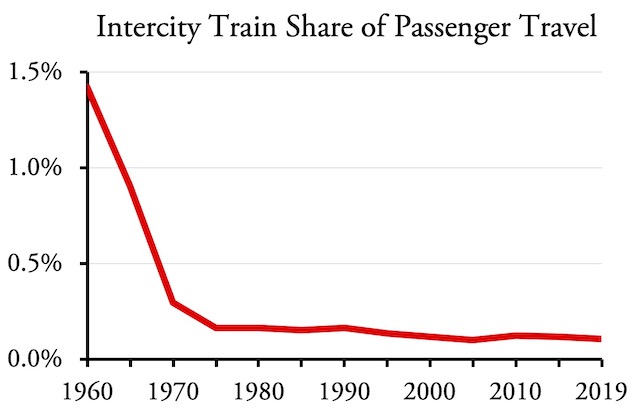
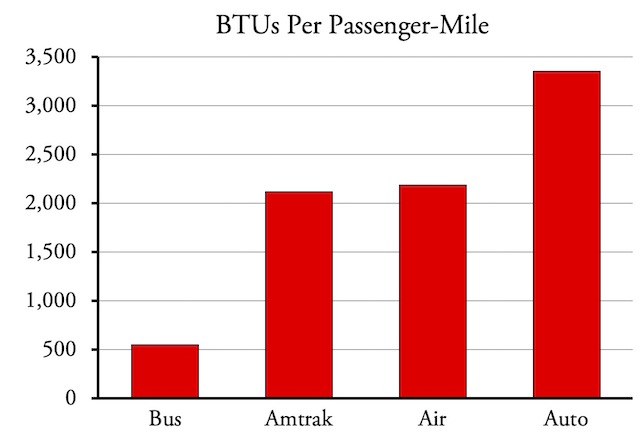
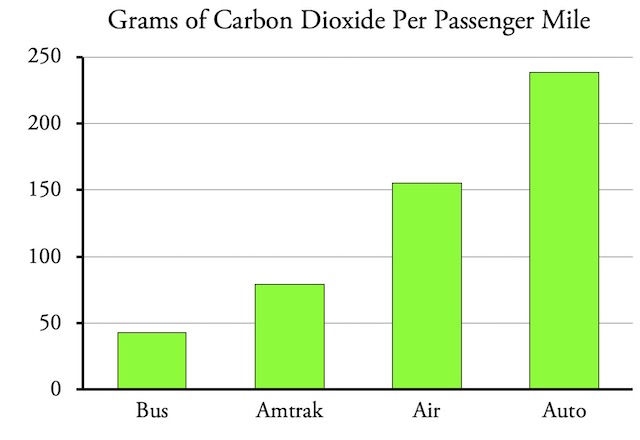
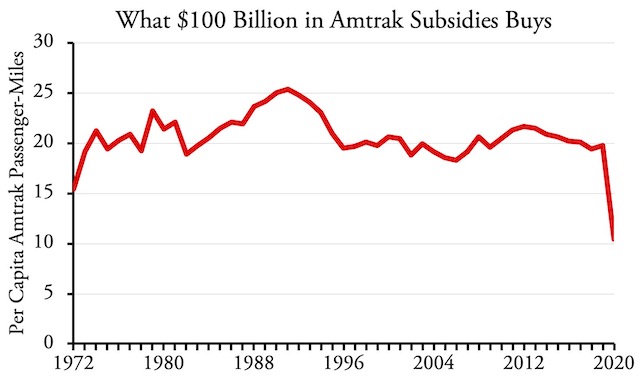







the Interstate Highway System, which was entirely self-funded out of gas taxes and other user fees, connects all major urban areas and carries about 20 percent of all passenger travel and more than 10 percent of all freight in the United States, Obama’s high-speed rail system would have been lucky to carry 1 percent of passenger travel.
WHile trains are dumb because they need new infrastructure, costs beared for lesser infrastructue, who said “Rails” have to sweep the nation. the Interstate already does that. Spoof in the onion about high speed buses, sounds like a joke but is it. Trolley buses with low center of gravity, speed oriented wheels can cross the interstate on dedicated lanes with little infrastructure and with electric power and torque can go at 100 mph on the highway.
A power plant has a higher efficiency than a car’s engine, and an electric motor has a higher efficiency than a combustion engine. But transmission losses chase away efficiency, generation on site was a common occurance in transit systems for over 100 years.
At 100 Mph any vehicle can accommodate 300 mile distances without air travel. Air travel is faster, but security and loading is not something govt is gonna fix.